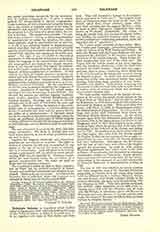

Delaware Indians, an important tribal confederacy of Algonquian stock originally holding the basin of the Delaware River, in Eastern Pennsylvania, U.S.A., together with most of New Jersey and Delaware. They call themselves Lenape or Leni-lenape, about equivalent to “real men”. The English knew them as Delawares, from the name of the river; the French called them Loups (wolves), under which term they included also the cognate Mahican; while to most of their Algonquian neighbors they were known as Wapanaki (Easterners). By reason of being the parent body of a number of cognate tribes, and holding the ancestral territory, they were accorded precedence in intertribal assemblies, under the respectful title of “grandfather”.
The Lenape proper consisted of three tribes—Munsee, Unami, and Unalaqtgo—symbolized respectively under the totems of the Wolf, Turtle, and Turkey. Of these the Munsee held the Upper Delaware and were considered the defenders of the frontier against the incursions of the hostile Iroquois. Their dialect differed considerably from that of the other two. The Unami held the middle course of the river, together with the hereditary chieftaincy, while the third tribe occupied the lower country. Each tribe was organized into clans or gentes, numbering about thirty-five in all, with descent in the female line, as usual among the Eastern Indians. In habit they were sedentary, depending chiefly upon agriculture rather than upon hunting, cultivating large quantities of corn, beans, squashes, and tobacco. Their houses, consisting of a framework of poles covered with bark or mats woven of rushes, were of wagon-top shape and accommodated several families each.
The most ancient traditions of the Lenape are contained in the sacred pictograph record known as the Walam Olum or “Red Score”, first brought to notice by Rafinesque in 1836 and published with translation and notes by Brinton in 1885. They made their first treaty, with Penn, in 1682, at Shackamaxon within the present limits of Philadelphia. To this period belongs their noted chief Tamenend, from whom the Tammany Society derives its name. As the whites pressed upon them the Delawares gradually retired westward, first to the Susquehanna and thence to the Alleghany, until in 1751 they began to make settlements in Ohio, where the greater part of the tribe was established at the outbreak of the French and Indian war in 1754. In common with all the other tribes of the Ohio region, they sided with the French against the English in this war and continued the struggle independently for some time after the French garrisons had been withdrawn. Throughout the Revolution and the war of 1812 they were allies of the English against the Americans. As early as 1746 zealous Moravian missionaries had begun work in the tribe in Easter a Pennsylvania, and succeeded in winning a considerable number to Christianity, despite persecutions and removals forced upon them by the whites, culminating in the massacre of an entire community of Christian Delawares at Gnadenhutton, in Ohio, in 1782.
The war of 1812 was followed by treaty cessions and other removals, most of the Christian Delawares emigrating to Canada, while the others, after various halts by different bands in Indiana, Missouri, Arkansas, and Kansas, were finally collected chiefly in the present Oklahoma, the main body incorporating with the Cherokee in 1867. They have greatly decreased, but number (1908) altogether about 1900 souls, including about 870 with the Cherokee and 95 more with the Wichita, in Oklahoma; about 250 Munsee in Wisconsin and some 50 more in Kansas; and the rest, under the names of Munsees and Moravians, on reservations in Ontario, Canada.
JAMES MOONEY

